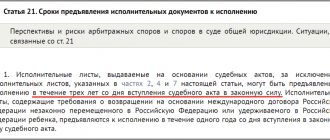Enforcement proceedings provide for several options for the claimant's actions, one of which is the transfer of a document - a sheet (IL), a court order, to the bailiff service. In this case, the law on enforcement proceedings comes into force, which regulates the time frame within which collection actions must be carried out. If they are unsuccessful, the sheet is returned to the bearer.
However, this does not deprive him of the right to re-submit a writ of execution for execution if information has appeared about a change in the financial situation of the debtor and the possibility of collecting the debt. How to resubmit the sheet and how many times you can submit it will be discussed in the article.
Deadline for submitting the writ of execution for execution again
QUESTION: A writ of execution was sent to the bailiff to collect the amount of the debt. After some time, the writ of execution was returned due to the debtor’s lack of money and property. Is it possible to submit it again, and what is the deadline for submitting a writ of execution for execution?
ANSWER: According to clause 4, part 1, article 46 of the Federal Law “On Enforcement Proceedings,” the writ of execution, according to which the collection was not carried out or was made partially, is returned to the claimant if the debtor does not have property that can be foreclosed on, and all accepted the bailiff's legal measures to find his property were unsuccessful; By virtue of Part 4 of Article 46 of the Law, the return of the writ of execution to the claimant is not an obstacle to the repeated presentation of the writ of execution for execution within the period established by Article 21 of this Federal Law. This article allows for the possibility of returning a writ of execution to the claimant if the debtor does not have funds, as well as any property through the sale of which the claimant can receive the funds due to him. However, the return of the writ of execution does not prevent the claimant from re-submitting it for collection. This provision is aimed at protecting the rights of the claimant and is due to the fact that some time after the return of the writ of execution, the debtor’s financial situation may change and property may appear, at the expense of which the execution of the court decision is possible. At the same time, there is a limitation - the deadline for presenting the writ of execution for execution is the period during which the claimant can re-submit the writ of execution.
Part 1 of Article 21 of the Federal Law “On Enforcement Proceedings”, writs of execution issued on the basis of judicial acts, with the exception of writs of execution specified in parts 2, 4 and 7 of this article, can be presented for execution within three years from the date of entry of the judicial act into legal force. Enforcement documents containing demands for the collection of periodic payments may be presented for execution during the entire period for which the payments are awarded, as well as within three years after the end of this period (Part 4 of Article 21 of the Law). This article establishes a general period of three years from the date the court decision enters into legal force. The exception is writs of execution for the collection of periodic payments; such writs of execution can be presented during the entire period of their execution. These periodic payments include, for example, alimony. Accordingly, a writ of execution can be presented during the entire period until the child turns eighteen years old, and after the child turns eighteen years old, within three years from the date of majority. If the writ of execution is filed after the expiration of the three-year period, it must be returned to the claimant. At the same time, a missed deadline can be restored provided that it was missed for a good reason, for example, due to the illness of the claimant.
According to Part 3 of Article 22 of the Federal Law “On Enforcement Proceedings”, in the event of the return of the writ of execution to the claimant due to the impossibility of its execution, the period for presenting the writ of execution for execution is calculated from the day the writ of execution is returned to the claimant. From this part of the article it follows that after the return of the writ of execution, the period for its re-presentation begins again, that is, from the moment the document is returned, the period for presenting the writ of execution for execution will also be three years.
It should also be noted that in case of return of the writ of execution to the claimant in accordance with paragraph 4 of part 1 of this article, the claimant has the right to re-submit for execution the writ of execution specified in parts 1, 3, 4 and 7 of Article 21 of this Federal Law, no earlier than six months from the date of the decision on the completion of enforcement proceedings and on the return of the writ of execution to the claimant, and other writs of execution no earlier than two months or until the expiration of the specified period in the event that the claimant provides information about a change in the property status of the debtor (Part 5 of Article 46 of the Law). It follows that the claimant has the right to re-apply to the bailiffs no earlier than six months after the return of the writ of execution.
From all of the above, we can conclude that upon repeated application, the period for presenting the writ of execution for execution will be three years from the date of its return, as it is three years upon the initial presentation of the writ of execution. Repeated presentation of the writ of execution is possible no earlier than six months after its return by the bailiff.
Sample application for re-initiation
An application for re-initiation of a case is drawn up in accordance with generally established rules for the preparation of procedural documents. Thus, this petition must indicate:
- position and full name of the FSSP bailiff;
- information about the applicant - full name, birthday, registration, contacts of an individual (citizen) or legal entity. address, OGRN, INN, legal contacts. faces;
- requirement for acceptance of the writ of execution for execution (its number, date of execution);
- information about the debtor - full name of the individual or name of the company;
- procedural actions (for example, a requirement to transfer the debtor’s money to the bank account details);
- date of application;
- personal signature of the applicant.
Download the form
Summary
1. In connection with the new laws on the limitation period, when the writ of execution is presented again to the bailiffs, the previous period is deducted only if the claimant himself revoked the writ of execution? Or if the bailiff completed the proceedings under Article 46, then this period is also taken into account?
1.1. Hello Nikolay. There is no new statute of limitations. In this regard, the essence of the issue is not clear.
1.2. What kind of new law is this? Give me some milk? Thank you).
2. Is it legal to present a writ of execution again if the statute of limitations has expired and what petition should I write to the bailiffs so that they stop the enforcement proceedings?
2.1. A writ of execution has no statute of limitations; the claimant has the right to present the writ of execution for execution an unlimited number of times.
2.2. It is necessary to appeal the decision to initiate enforcement proceedings in court in accordance with the CAS RF procedure.
2.3. Good afternoon. Read the following articles from the Federal Law “On Enforcement Proceedings”. Perhaps in your case the statute of limitations has not expired, since there was a break. It’s not just that you mentioned the repeated presentation of the writ of execution.
Article 21. Time limits for presenting writs of execution for execution
1. Writs of execution issued on the basis of judicial acts, with the exception of writs of execution specified in parts 2, 4 and 7 of this article, can be presented for execution within three years from the date the judicial act enters into legal force. Writs of execution containing demands for the return, on the basis of an international treaty of the Russian Federation, of a child illegally transferred to the Russian Federation or detained in the Russian Federation, are presented for execution within one year from the date of entry into force of the judicial act. (as amended by Federal Laws dated 05.05.2014 N 126-FZ, dated 03/08/2015 N 57-FZ) (see text in the previous edition) 2. Writs of execution issued on the basis of judicial acts of arbitration courts, according to which the arbitration court has reinstated a missed deadline for presenting a writ of execution for execution may be presented for execution within three months from the date the court issues a ruling to restore the missed deadline. 3. Court orders may be submitted for execution within three years from the date of their issue. 4. Enforcement documents containing demands for the collection of periodic payments may be presented for execution during the entire period for which payments are awarded, as well as within three years after the end of this period. 5. Certificates issued by labor dispute commissions may be presented for execution within three months from the date of their issue. 6. Acts of the bodies exercising control functions drawn up in the established manner on the collection of funds with the attachment of documents containing marks of banks or other credit organizations in which settlement and other accounts of the debtor are opened, on complete or partial failure to fulfill the requirements of these bodies due to the lack of funds in the debtor's accounts sufficient to satisfy these requirements may be presented for execution within six months from the date of their return by the bank or other credit institution. 6.1. Acts of bodies exercising control functions drawn up in the established manner on the collection of funds without attaching the documents specified in Part 6 of this article can be presented for execution within six months from the date of their issuance. (Part 6.1 introduced by Federal Law No. 358-FZ of December 21, 2013) 7. Judicial acts, acts of other bodies and officials in cases of administrative offenses can be presented for execution within two years from the date of their entry into legal force. (as amended by Federal Law No. 71-FZ of April 21, 2011) (see the text in the previous edition) 8. The deadlines for presenting for execution executive documents not specified in this article are established in accordance with federal laws. 9. If a federal law or a judicial act, an act of another body or official sets a deadline for the debtor to fulfill the requirements contained in an executive document, or is granted a deferment or installment plan for the execution of these requirements, the duration of the period for submitting such an executive document (excluding the executive document on collection of a fine imposed as punishment for committing a crime) begins after the expiration date of the period established for the debtor to fulfill the requirements contained in the writ of execution, granting him a deferment or installment plan for the fulfillment of these requirements.
Article 22. Break of the deadline for presenting a writ of execution for execution
Article 128. The procedure for challenging decisions of officials of the bailiff service, their actions (inaction)
1. Resolutions of an official of the bailiff service, his actions (inaction) regarding the execution of a writ of execution may be challenged in an arbitration court or a court of general jurisdiction in the manner established by the procedural legislation of the Russian Federation, taking into account the specifics established by this Federal Law. (as amended by Federal Law dated December 30, 2015 N 425-FZ) (see text in the previous edition) 2. An application to challenge the decision of an official of the bailiff service, his actions (inaction) is submitted to the arbitration court in the following cases: 1) execution a writ of execution issued by an arbitration court; 2) fulfillment of the requirements contained in the executive documents specified in paragraphs 5 and 6 of part 1 of Article 12 of this Federal Law in relation to an organization or citizen carrying out business activities without forming a legal entity; 3) execution of the order of the bailiff, issued in accordance with Part 6 of Article 30 of this Federal Law, if the debtor is an organization or citizen engaged in business activities without forming a legal entity, and enforcement proceedings were initiated in connection with its business activities; 4) in other cases established by the arbitration procedural legislation of the Russian Federation. 3. In cases not specified in part 2 of this article, the application is submitted to a court of general jurisdiction. 4. The consideration of the application by the court is carried out within ten days according to the rules established by the procedural legislation of the Russian Federation, taking into account the specifics established by this Federal Law.
This is interesting: Current account asset or liability
3. I received a protocol on the completion of enforcement proceedings on the writ of execution. Question 1: is it possible to re-submit a writ of execution to the bailiffs? Question 2: will the deadline for presenting a writ of execution be calculated anew? Again, 3 years after the issuance of the protocol on the completion of enforcement proceedings?
3.1. 1. possible; 2 again 3 years; also see on what grounds the production was returned;
Federal Law of 02.10.2007 N 229-FZ (as amended on 03.08.2018) “On Enforcement Proceedings” (as amended and additionally, entered into force on 03.09.2018) “” Article 46. Return of the writ of execution to the claimant after initiation of enforcement proceedings
3.2. Hello, you can resubmit the writ of execution no earlier than six months from the date of the decision to end the enforcement proceedings and return the writ of execution to the claimant, in accordance with Art. 21, 46 Federal Law "On enforcement proceedings" The period of three years also remains.
3.3. If the bailiff graduated from the IP under clause 1 of Part 1 of Article 46 of the IP, then the period of 3 years is not recalculated. The time spent in production is not taken into account. document from the bailiffs. If according to clause 3, part 1. Article 46, then the period for presentation starts again from the date of termination of the IP by the bailiff. You can reapply at least the next day after graduation. If according to clause 4 part 1. Article 46, then the period for presentation starts again from the date of termination of the IP by the bailiff. Submission isp. document again only 6 months after the end of the IP.
4. The statute of limitations for re-submitting a writ of execution for collection is three years from the date of the decision to terminate the IP (Clause 4, Part 1, Article 46) and the return of the IP to the recoverer. And if, after issuing a decision to end the IP, the bailiff did not return the IL (as the creditor assures). So there was no statute of limitations? Thank you in advance.
4.1. You should not trust the lender. I recommend that you contact the bailiff service and ask them for copies of documents confirming the sending and receipt of the writ of execution by the claimant (the writ of execution is handed over to the claimant personally against signature or sent by registered mail with notification). In accordance with the Federal Law of October 2, 2007 No. 229-FZ “On Enforcement Proceedings,” a resolution is issued on the termination of enforcement proceedings. Copies of the bailiff's decision on the completion of enforcement proceedings no later than the day following the day of its issuance are sent to the claimant and the debtor. If the claimant was not notified of the time and place of the action (did not receive a copy of the resolution on completion), then the bailiff’s decision on the termination of enforcement proceedings can be appealed within ten days from the day when this person learned or should have known about making a decision. Thus, the period will be calculated from the date of adoption of the resolution on the completion of enforcement proceedings, and not from the moment the claimant receives the writ of execution.
5. From what time does the statute of limitations for re-submitting a writ of execution for collection begin? Three years from the date of the decision to terminate the IP (clause 4, part 1, Article 46) or from the moment the IP was returned to the claimant? And if after the end of the IP the bailiff did not return the IL (as the creditor assures). So there was no statute of limitations? Thank you in advance.
5.1. Good day.
In accordance with Art. 22 Federal Law “On Enforcement Proceedings”:
1. The deadline for presenting a writ of execution for execution is interrupted: 1) by presenting a writ of execution for execution; 2) partial execution of the writ of execution by the debtor. 2. After the break, the period for presenting the writ of execution for execution is resumed. The time elapsed before the deadline is interrupted does not count towards the new deadline. 3. If the writ of execution is returned to the claimant due to the impossibility of its execution, the period for presenting the writ of execution for execution is calculated from the day the writ of execution is returned to the claimant. 4. If the execution of a judicial act, an act of another body or official has been delayed or suspended, then the period for submitting a writ of execution for execution shall be resumed from the day the execution of the judicial act, act of another body or official is resumed. 5. If the debtor is granted an installment plan for fulfilling the requirements contained in the writ of execution, such a writ of execution may be presented for execution without observing the rules established by Part 9 of Article 21 of this Federal Law, if the debtor has failed to fulfill part of the requirements contained in the writ of execution more than twice. executive document according to which he was granted an installment plan. 6. The effect of parts 1 - 4 of this article does not apply to judicial acts, acts of other bodies and officials in cases of administrative offenses.
6. A writ of execution was sent to the bailiff to collect the amount of the debt. After some time, the writ of execution was returned due to the debtor’s lack of money and property. Is it possible to submit it again, and what is the deadline for submitting a writ of execution for execution?
Federal Law of October 2, 2007 N 229-FZ (as amended on April 23, 2018) “On Enforcement Proceedings” (as amended and supplemented, entered into force on June 1, 2018) Article 46. Return of the writ of execution to the claimant after the initiation of the writ of execution production
5. If the executive document is returned to the claimant in accordance with paragraph 4 of part 1 of this article, the claimant has the right to re-submit for execution the enforcement documents specified in parts 1, 3, 4 and 7 of Article 21 of this Federal Law, no earlier than six months from the date of the decision on the completion of enforcement proceedings
and on the return of the writ of execution to the recoverer, and other writs of execution no earlier than two months or before the expiration of the specified period if the recoverer provides information about a change in the debtor’s property status.
6.2. Good evening. If the enforcement proceedings are completed due to the debtor’s lack of funds, then the sheet can be presented again no earlier than 6 months from the date of completion of the enforcement proceedings. The total period for presenting a writ for collection is 3 years from the date of its issuance by the court.
7. Individual entrepreneur closed on December 13, 2014, article 46, part 1, clause 4. Writ of execution dated December 20, 2011. Debt for road accident insurance payment. When does the statute of limitations expire and is it possible to re-present the IL for execution?
7.1. Hello, There are no statutes of limitations for collecting debt by court decision, but the writ of execution must be presented for execution within three years, or it must be renewed for a new term. I wish you good luck and all the best!
7.2. A writ of execution can be presented for execution within three years from the date of its return to the claimant; after three years, upon presentation of the writ by the bailiff, acceptance for execution will be refused.







